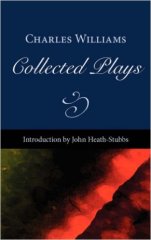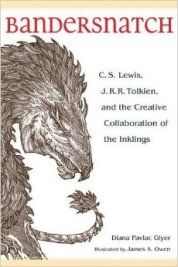 Now, this is a sweet, simple, profound, and moving play. It is very, very good. I know I have high praise for the latent or potential value of such early works as The Chapel of the Thorn or The Silver Stair or the Masques of Amen House—but this play, The House by the Stable from 1939, this is a very good piece of drama. There are three important points relating to this play that I want to discuss: 1) The Inklings; 2) The play itself; 3) Its performance history and legacy.
Now, this is a sweet, simple, profound, and moving play. It is very, very good. I know I have high praise for the latent or potential value of such early works as The Chapel of the Thorn or The Silver Stair or the Masques of Amen House—but this play, The House by the Stable from 1939, this is a very good piece of drama. There are three important points relating to this play that I want to discuss: 1) The Inklings; 2) The play itself; 3) Its performance history and legacy.
I. The Inklings
On the 11th of November, 1939, C. S. Lewis wrote a letter to his brother Warnie describing a meeting of the Inklings. On the past Thursday evening, he said, they
had a section of the new Hobbit book by Tolkien, a nativity play by Williams (unusually intelligible for him, and approved by all) and a chapter out of the book on the Problem of Pain from me.
Lewis goes on to say that the three readings fit together remarkably well, making almost a logical sequence. Scholars have determined that Tolkien was reading from the end of Book One of The Fellowship of the Ring, and that the “unusually intelligible” play by Williams was this one, The House by the Stable. They speculate that the theme of the three works—or at least of the conversation afterwards—was the Problem of Evil. In any case, it was a quintessential Inklings: a meeting at which three of the most significant members read from works that would actually be published (and, in Williams’s case, performed) and receive some public acclaim. Meetings like this one are at the core of who the Inklings were.
 I strongly recommend Diana Pavlac Glyer’s new book Bandersnatch: C. S. Lewis, J. R. R. Tolkien, and the Creative Collaboration of the Inklings. It is all about how the Inklings worked together with one another to discuss, critique, revise, edit, and promote one another’s books—and it’s also a handbook for how to imitate their creative and collaborative practices in your own writer’s workshops. I hope to employ some of its principles in Ekphrasis, as indeed we have been doing all alone, naturally, and partly because I have been so steeped in the Inklings all my life.
I strongly recommend Diana Pavlac Glyer’s new book Bandersnatch: C. S. Lewis, J. R. R. Tolkien, and the Creative Collaboration of the Inklings. It is all about how the Inklings worked together with one another to discuss, critique, revise, edit, and promote one another’s books—and it’s also a handbook for how to imitate their creative and collaborative practices in your own writer’s workshops. I hope to employ some of its principles in Ekphrasis, as indeed we have been doing all alone, naturally, and partly because I have been so steeped in the Inklings all my life.
Here’s an idea: does anybody want to write a guest post in which you compare the themes of the end of Book One of LOTR, The House by the Stable, and The Problem of Pain? If not, I’ll carve out time to do so someday. It would be a brilliant glimpse into the heart of these men’s works and interactions.
II. The Play Itself
So, Lewis called The House by the Stable “unusually intelligible” for CW. Indeed. It is short, tight, and simple. Yes, simple. The poetry is clear and straight-forward. If you read just one play by Williams, ever, make it this one. It is surprisingly emotionally powerful; even reading it the first time, I get some little hints of tears at the beautiful ending. It’s a very plain, unadorned story of salvation. But it’s also an Allegory.
Yes, Tolkien; it’s an Allegory. Deal with it. (I imagine that topic must have come up for discussion after CW read this to the Inklings, as Tolkien famously disliked Allegory—even though he used it himself in “Leaf by Niggle” and “Smith of Wooton Major”). And the allegory is extremely subtle and skillful, even while being plain and obvious. How can it be subtle and obvious at once? Well, the character’s names are symbolic: the three main characters are called Man, Pride, and Hell. Not a lot of hiding of the inner meaning there. But then many of the lines play with the allegory in gentle, careful, well-woven ways. For instance, Man is in love with the woman Pride and keeping her as a mistress. He is praising her, exulting in his possession of her, and he asks: “will you be / so arrogant always to others and humble to me?” Isn’t that exactly how pride works? It is arrogant toward everyone else but submissive to my own beck and call. It does whatever I ask it to do, as long as that serves to bolster my own ego. Then later, when Pride introduces Man to her dear brother Hell, the Man asks: “And where, Hell, do you live?” Hell answers:
…it is not far
as your journeys go, and no bar to finding,
but the minding of the way is best found by going,
and that (of all means) best at my sister’s showing.
This is an example of perfectly controlled allegory: the speech works smoothly and totally on either of the two levels, and also entirely well at both levels together.
The plot is simple and profound. Man is cohabiting with Pride. She introduces her brother, Hell. Hell offers to give Man a lovely house in his own lands. Man wants to pay for the house. Pride suggests that they play a game of dice, and if Hell wins, he will choose his price for the house. Man agrees. The price is a certain jewel that Man can’t even remember owning, doesn’t know where he has put it: his soul. So they play. Pride kisses man and dallies with him so that Hell can switch the loaded dice around and win by cheating. Just then, Man’s servant Gabriel (!) comes in and announces that a poor young couple is at the door, begging for shelter for the night. The lady is about to have a baby. Man is torn between his Pride and his desire to help. So he refuses to let them stay in his house, but he puts them into his stable. I won’t spoil the ending for you, but let me say it is lovely and moving, although completely predictable and traditional.
It’s a sweet, lovely play. Those aren’t words I usually use for CW. If you are a theater director and want to mount a performance of a play by Williams, chose this one. (Sharon Gerdes, can Players of the Stage do an alumni production of it this coming Christmas??!! It would be fantastic!). It has only a six-member cast:
Man
Pride
Hell
Gabriel
Joseph
Mary
There need be no set whatsoever, or it could have an elaborate set: it could be done in a black box, a living room, or anywhere. It takes place in Man’s house, which we are lead to believe is rather opulent; but as this work is a Nativity play, it could take place in a first-century home in Palestine; but as it is an Allegory, it really takes place Everywhere and Nowhere. So the choice is up to the director’s taste, interpretation, and budget.
Which leads me to….
III. Its performance history and legacy.
This is yet another of CW’s plays written on commission for a particular group. It was written for his friend Ruth Spalding, in whose home he stayed when he was evacuated from London to Oxford with the Press. Her group the Oxford Pilgrim Players performed it at Christmas 1939, I think, but I’m not at home to check my references. In any case, you can tell that CW had learned a lot about drama between 1912 and 1939, or even since the Amen House masques in the mid-1920s. This works seems to be much kinder to its audience, taking into account the fact that spoken lines pass by in time and can’t be reread, and focusing on pure human/spiritual drama rather than a great metaphysical montage.
Ruth Spalding is a fascinating character, and I would like to study her more. She had an important role in the revival of religious drama in the first half of the 20th century. And, astonishingly, she wrote a BBC radio broadcast called A Portrait of Charles Williams in 1961. I have not yet found out anything else about it, except for this shocking and perplexing list, and the fact that it was read (by the author) at a meeting of the CW Society in 1992. Perhaps some of my dedicated readers were even at that meeting in 1992 and can inform me further?
In conclusion, this is a lovely little play, and I hope you enjoy it. Maybe you can make it part of your Christmas reading this coming year. I recommend it highly.

See series 3 in the “Ruth Spalding Collection” for more on “A Portrait of Charles Williams.” Available at the Wade Center. Finding aid: http://www.wheaton.edu/~/media/Files/Centers-and-Institutes/Wade-Center/RR-Docs/Finding-Aids/W-Spalding.pdf
LikeLike
Yes, I saw that! It’s super exciting. I hope to read the script next time I’m at the Wade. Thanks so much!!
LikeLike
In her 1983 Charles Williams: An Exploration book, Alice Mary Hadfield quotes Anne Ridler that the Pilgrim Players gave performances of it “in halls, air-raid shelters, garages, churches, schools and theatres in many parts of the country” and herself adds that it “was taken to the Forces in northwest Europe in May 1945 by E. Martin Browne and was broadcast.” As you say, very versatile as to circumstances of performance – and even, while seasonal, not season-bound! (Compare, perhaps, the mediaeval mystery play cycles.)
LikeLike
Thanks so much! I was at school when I wrote this and didn’t have my books to hand. Thanks for the important addition!
LikeLike
My pleasure! (I haven’t yet checked her earlier book to see if it has more…) I have an index to the content of some of the Williams Society Newsletters/Quarterlies, sent out to members (or maybe more than one) – alas, not immediately accessible. It would be a quick way to some of Ruth Spalding’s contributions, there, for all those issues online at the Society website – not that browsing through them isn’t interesting, too (just not as efficient a starting point). Maybe if someone else knows where his or her index copy is, it could be posted on the site together with the archive!
The catalog of Papers in the Society archive lists things with references to American performances in 1957, ’58, ’59, (maybe ’60), and ’63. (It also lists letters from Charles, and one from Michal, Williams to Ruth Spalding.)
LikeLike
Pingback: CW’s Nativity Plays | The Oddest Inkling
Pingback: An Upcoming Adventure | The Oddest Inkling
Pingback: Upcoming Adventures – Sørina Higgins
Pingback: Surprisingly Sexy: The House by the Stable | The Oddest Inkling